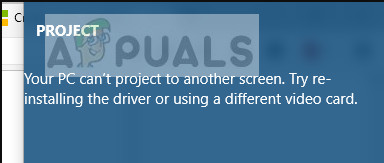This error is very common and mostly signifies that you require updated graphics drivers or there may be a problem with the cables. Don’t worry as this is a very common error and can be fixed with very simple workarounds.
Solution 1: Checking Hardware
Before we move on to updating the graphics drivers, you should first check if the cables are properly connected to the monitor and your CPU or laptop. Also make sure that all cables are plugged in the correct ports such as HDMI, VGA, etc. Try pressing the cables fully inside the ports until you are sure that all the mini-components inside the wire are connected. Make sure both ends of the wire are correctly in place. Once you are sure that everything is connected including the power cables, Press Windows + P and try projecting again.
Solution 2: Running Hardware and Device Troubleshooter
Hardware Troubleshooter is a utility present in the Windows operating system. It detects problems with your existing hardware and tries to resolve it after following a series of steps. We can try running the hardware troubleshooter and check if this does the trick.
Solution 3: Updating Graphics Drivers (Main fix)
It is possible that your display drivers are either outdated or are corrupt. As we all know, Windows keeps updating itself and with that, the graphics adapters also respond to the updates by implementing some updates of their own. If can also be the case that the new drivers are not stable; hence we will first force your computer to install the default drivers. If installing the default drivers don’t work, we will install the latest drivers after downloading them from the manufacturer’s website. We will start your computer in Safe Mode and delete the currently installed drivers of your display card. Upon the restart, the default display drivers would automatically be installed upon the detection of your display hardware.
Upon the restart, the default drivers will automatically be installed against the graphics hardware. After the restart, check if you can properly project. However, If installing the default drivers doesn’t solve the problem in question, you can try downloading and installing the drivers manually from your Manufacturer’s website. Do note that you have to research by yourself and see which drivers are latest or which drivers you should downgrade to. Manufacturers have all the drivers listed according to date and you can try installing them using the device manager. You can either simply run the installation file you downloaded to install the drivers after uninstalling them using the method above or you can update them using the method listed below. Also, it is worth noting that Intel HD Graphics are not exempted from the drivers update. You should also check them for any potential updates available or roll them back.
Tip: You can also use utilities like Intel Driver Update Utility. It automatically detects the drivers needed and prompts to install them.
Microsoft ‘Project Reunion’ To Unify Win32 And UWP Apps For Windows 10X On…Fix: Another app is controlling your Sound 0xc00d4e85How to Host Another Twitch Channel on Your StreamHow to move your OneNote 2016 Notebook to another OneDrive account









